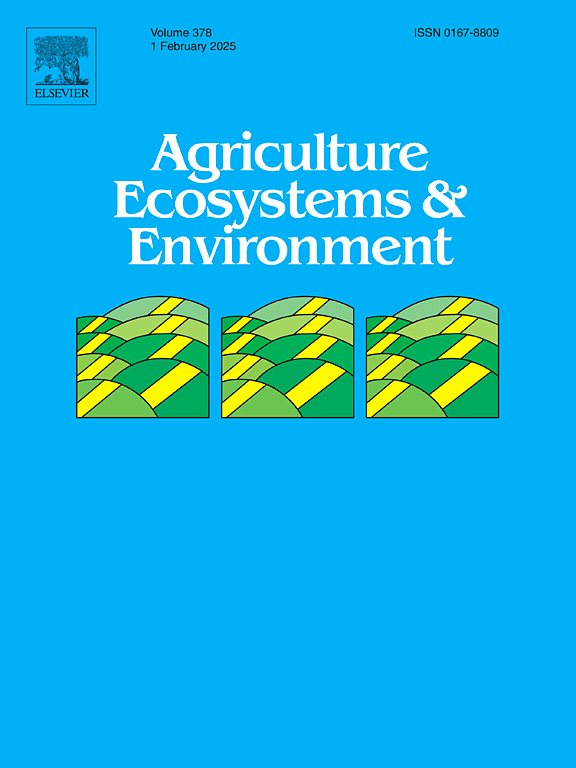并不是所有的花的访客都是传粉者:结合指标来确定他们在可可授粉服务中的作用
IF 6.4
1区 农林科学
Q1 AGRICULTURE, MULTIDISCIPLINARY
引用次数: 0
摘要
动物授粉对野生植物繁殖和作物产量至关重要。然而,并不是所有的访花者都是传粉者。本文以可可(Theobroma cacao L.)为研究对象,探讨了花客传粉效果的综合评价指标。我们首先在控制条件下的手传粉试验中研究了花粉沉积的质量和数量对传粉成功限制的潜在权衡。结果表明,坐果率和胚珠受精率主要受花粉粒沉积量的影响。然后,我们在厄瓜多尔的田地里进行了横断面和视频监控,用几个指标来比较可可花访客作为传粉者的表现。我们发现,小型爬行节肢动物,特别是蚂蚁和蚜虫,被证明是有希望的传粉者,在它们访问的花朵上观察到更高水平的花粉。蚂蚁甚至比其他访客更有效地将大量花粉粒沉积在花柱上。相反,无刺蜜蜂和微双翅目昆虫在储存花粉时效率较低,但在采花时与小型爬行节肢动物互补。有趣的是,我们发现其他的可可花访客对授粉服务是有害的,比如半足类若虫和毛虫。我们得出结论,可可种植园管理注重增加传粉者访问的互补性,在一天中的不同时段和不同行为,可以改善授粉服务,并且在未来的研究中应提倡使用多种指标来评估传粉者的有效性。本文章由计算机程序翻译,如有差异,请以英文原文为准。
Not all flowers' visitors are pollinators: Combining indicators to identify their role in the cocoa pollination service
Animal pollination is critical for wild plant reproduction and crop yield. However, not all flower visitors are necessarily pollinators. Using cocoa (Theobroma cacao L.) as a case study, we explored a combination of indicators to assess the effectiveness of flower visitors as pollinators. We first investigated the potential trade-off between the quality and quantity of pollen deposited on the limitation of pollination success in a hand pollination trial under controlled conditions. We found that the fruit set and ovule fecundation rate are mainly driven by the quantity of pollen grain deposited. We then conducted transects and video monitoring in the field in Ecuador to compare the performance of cocoa flower visitors as pollinators using several indicators. We found that small crawling arthropods, in particular ants and aphids, proved to be promising pollinators, with a higher level of pollination with viable pollen being observed on the flowers they visited. Ants were even more efficient than other visitors in depositing significant numbers of pollen grains on the styles. Instead, stingless bees and microdiptera were less efficient when depositing pollen, but complementary to small crawling arthropods in the time of flower visits. Interestingly, we found that others cocoa flower visitors were detrimental to the pollination service, such as hemipteran nymphs and caterpillars. We conclude that cocoa plantation management focused on increasing the complementarity of pollinator visits, acting at different periods of the day and with distinct behaviours, could improve pollination services, and that the use of multiple indicators should be advocated in future research to assess pollinator effectiveness.
求助全文
通过发布文献求助,成功后即可免费获取论文全文。
去求助
来源期刊

Agriculture, Ecosystems & Environment
环境科学-环境科学
CiteScore
11.70
自引率
9.10%
发文量
392
审稿时长
26 days
期刊介绍:
Agriculture, Ecosystems and Environment publishes scientific articles dealing with the interface between agroecosystems and the natural environment, specifically how agriculture influences the environment and how changes in that environment impact agroecosystems. Preference is given to papers from experimental and observational research at the field, system or landscape level, from studies that enhance our understanding of processes using data-based biophysical modelling, and papers that bridge scientific disciplines and integrate knowledge. All papers should be placed in an international or wide comparative context.
 求助内容:
求助内容: 应助结果提醒方式:
应助结果提醒方式:


